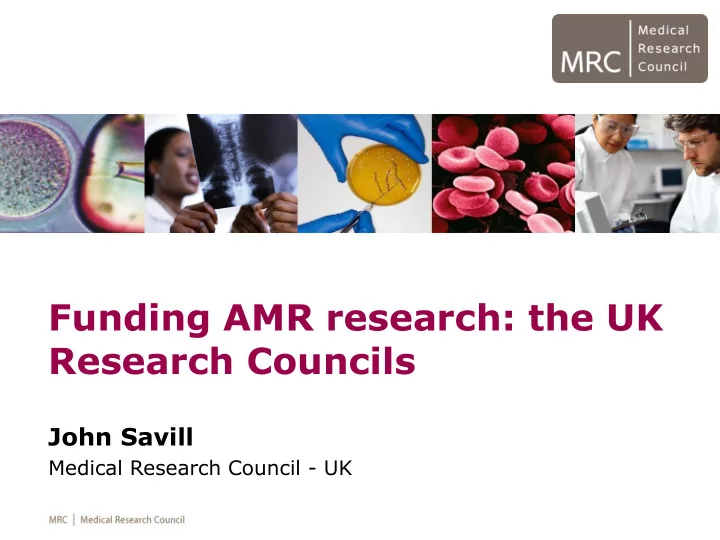

Funding AMR research: the UK Research Councils John Savill Medical Research Council - UK
MRC mission • Encourage and support high-quality research with the aim of improving human health. • Produce skilled researchers. • Advance and disseminate knowledge and technology to improve the quality of life and economic competitiveness in the UK and worldwide. • Promote dialogue with the public about medical research.
MRC investment in research, 2012/13 MRC research expenditure - € 926.2 million in 2012/13 • € 414.4m on around 400 programmes in MRC research units and institutes (inc € 9.9m on studentships). • € 404.1m on around 1,400 grants to researchers in universities, medical schools and research institutes. • € 86.1m on studentships and fellowships in universities, medical schools and research institutes.
The UK: A rich network of funders and researchers UK Government Departments OSCHR Research Technology community Strategy Board Research Public UK Clinical Research Councils Collaboration Parliamentarians Policy-makers NIHR Learned societies Industry DEFRA Universities International Medical charities Patients and carers NHS
AMR research in the UK • Growing concern of AMR: a political and societal priority • The research councils: broad remits; support AMR across the whole of the research spectrum Research Councils portfolio: ~ € 30m per year on AMR
What is needed? • Collaborative working • Coordination of key disciplines • Coordinating research funding – government and other research funders including industry • Ensuring integration with human/animal healthcare UK AMR Funders Forum
AMR Funders Forum (AMRFF) • Made up of representatives from the research councils, governmental bodies and charities • Led and managed by the MRC • Has a common vision for AMR research and its implementation • Will add value to existing programmes • Will coordinate and/or support the initiation of funding and delivery programmes • Will raise the profile of the AMR research base in the UK and internationally
AMRFF current membership • The Biotechnology and Biological • HSC R&D Division, Public Health Sciences Research Council Agency, Northern Ireland (BBSRC) • *The Medical Research Council • DEFRA, the Veterinary Medicines (MRC) Directorate • National Institute of Health • The Department of Health Research (NIHR) • The Economic and Social • The Natural Environment Research Council (ESRC) Research Council (NERC) • The Engineering and Physical • The Science and Technology Sciences Research Council Facilities Research Council (STFC) (EPSRC) • The Technology Strategy Board • The Food Standards Agency (TSB) • The Wellcome Trust
Research priorities identified • Understanding resistant bacteria in context: from genomic, through to cellular and host pathogen interaction • Accelerating therapeutic and diagnostics development : development and revisiting of small molecule antibiotics, new non-small molecule based treatments and diagnostics • Understanding real world interactions : how resistant bacteria affect their environments and vice versa. New sources of antibiotics • Behaviour and care: behaviour change in human and animal healthcare settings. New business models needed for antibiotics development
UK spend on AMR (since 2007) Total funding: € 337m € 0.6m € 26.6m Therapeutics € 20.4m Diagnostics € 20.6m Underpinning Surveillance Alternatives Optimisation Transmission Lead compounds € 200m € 68.7m Environment Interventions
The breadth of current research Major UK investments: • Understanding bacteria: Eg: Centre for Molecular Bacteriology and Infection • Technology to reduce infection: Eg: Early Warning Sensing Systems i-Sense (EPSRC) • Links with industry: Eg: New anti-bacterial to treat MRSA (BBSRC) • Environment: Eg: NERC Centre for Ecology and Hydrology: modelling antibiotics usage
Current joint initiatives • 4 x UKCRC Translational Infection Research Initiative consortia, MRC-led joint initiative University of Oxford, Derrick Crook (genomics to detect transmission) Imperial, Jonathan Friedland (Health Care Associated Infection and AMR) University of Cambridge, Sharon Peacock (MRSA transmission) University of London, Tariq Sadiq (Diagnostics and STIs) • Environmental and Social Ecology of Human Infectious Diseases (ESEI) MRC-led, as part of LWEC novel inter-disciplinary approaches to studying the ecology of infectious diseases
Cambridge UKCRC Consortium UK MRSA investigation network: a case study English referral network : Donker, Wallinga and Grundmann , PLoS 2012
Case study outcomes • Whole genome sequencing tools to detect patterns of MRSA transmission • Transmission modelling within a hospital and between hospitals • UK hospital: Addenbrooke – Cambridge Netherlands hospital: University Medical hospital – Groningen • MRSA rate reflects connectivity of the hospital – more movement and referral between hospitals, less control of MRSA • Hospitals that share >50 patients / year share homogenous MRSA
Developing international links - highlights • JPIAMR: MRC lead on behalf of the UK • Canada: 2 x UK-CIHR Partnership on antimicrobial resistance consortia University of Cardiff (Tim Walsh) and Canada (Gary Dmitrienko) University of Warwick (Chris Dowson) and Canada (Anthony Clarke) • BBSRC partner of Global Strategic Alliance for coordination of research on major infectious diseases of animals and zoonoses • Currently identifying international opportunities via RCUK offices in China, India and USA
Providing excellent underpinning resources • Medical Bioinformatics call Universities of Warwick and Swansea: The MRC Consortium for Medical Microbial Bioinformatics (wide range of research including AMR surveillance and data sharing) • The Farr Institute : for health informatics research • Linking with Industry IMI: the MRC represents the UK Revisiting old compounds with new science TSB/MRC Biomedical Catalyst fund Eg: The use of light activated antimicrobials to prevent catheter related infection. Ivan Parkin, UCL
The next steps Develop new research opportunities • Academic/private sector • International • Develop new treatments • Develop new diagnostics • Develop surveillance systems • Uptake by human/animal healthcare providers •
Recommend
More recommend